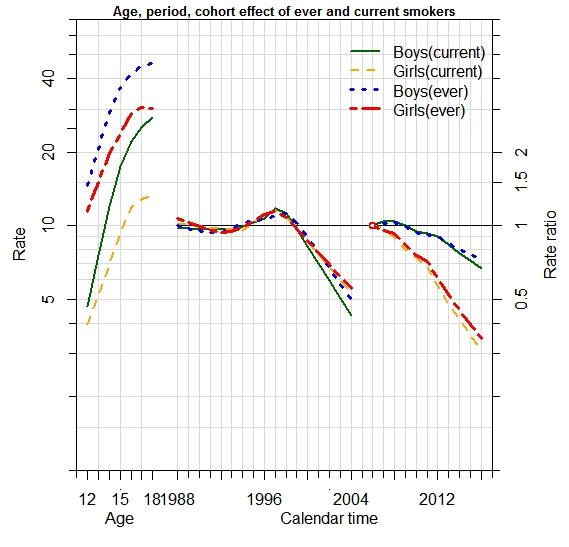Recent manuscripts
Archive
Editorial Board
Aims and Scope
Open Access
Indexing
Contact us
Authorship & COI
Principles of Transparency Checklist
Publication Ethics
Crossmark
Data Policies
Supporting Diversity
Instructions to authors (PDF)
Manuscript Types
Manuscript Formatting
How to submit
Special Publications & Reprints
Preprints
Age-period-cohort effect of adolescent smoking in Korea: from 2006-2016
1
Department of Public Health Science, Graduate School of Public Health, Seoul National University, Korea, Republic of
2
Institute of Health and Environment, Seoul National University, Korea, Republic of
Publication date: 2018-03-01
Tob. Induc. Dis. 2018;16(Suppl 1):A420
KEYWORDS
TOPICS
ABSTRACT
Background:
Achievement of a tobacco-free generation depends on the use on tobacco among adolescents. Targeting to reduce smoking from adolescence can be effective because experimentation of tobacco smoking in adolescence is a strong predictor of tobacco use throughout the later life-course. With governmental efforts to reduce tobacco-use among adolescents since 1999, smoking prevalence of Korean adolescents decreased from 12.8% in 2006 to 6.3% in 2016. However, the ultimate goal is to reach smoking prevalence of 0% among adolescents. In order to achieve such goal, continuous monitoring of smoking prevalence is indispensable.
Methods:
Data were acquired from the Korea Youth Risk Behavior Risk Survey, which has been conducted every year since 2005. Data from the first survey which was conducted in 2005, were excluded because the third grades of high schools were not surveyed due to a scheduled national college examination. Measures such as age, sex and tobacco use(ever/current) were used. This study applied age-period-cohort analysis on time trends of adolescent smoking to examine the effect of chronological age, period and birth cohort. All statistical analyses were performed using R.
Results:
Current smoking was positively associated with age in both sexes. Ever smoking also increased as age advanced among boys, but decreased at the age of 18 among girls. The cohort effect suggests that there was not much difference in current smoking for newborns between 1988 and 1997. However, for newborns from 1998, current smoking was negatively associated with birth year. Ever smoking showed similar patterns. Period effect was dramatic as current and ever smoking decreased as time advanced. However, the effect was less striking among boys.

[Age, period, cohort effect in adolescent smokers]
Conclusions:
Efforts to reduce tobacco-use among adolescents appears to be playing a substantial role in reducing current smoking and ever smoking prevalence. Ongoing surveillance for trends in adolescent cigarette smoking is essential to implement effective tobacco control programs.
Achievement of a tobacco-free generation depends on the use on tobacco among adolescents. Targeting to reduce smoking from adolescence can be effective because experimentation of tobacco smoking in adolescence is a strong predictor of tobacco use throughout the later life-course. With governmental efforts to reduce tobacco-use among adolescents since 1999, smoking prevalence of Korean adolescents decreased from 12.8% in 2006 to 6.3% in 2016. However, the ultimate goal is to reach smoking prevalence of 0% among adolescents. In order to achieve such goal, continuous monitoring of smoking prevalence is indispensable.
Methods:
Data were acquired from the Korea Youth Risk Behavior Risk Survey, which has been conducted every year since 2005. Data from the first survey which was conducted in 2005, were excluded because the third grades of high schools were not surveyed due to a scheduled national college examination. Measures such as age, sex and tobacco use(ever/current) were used. This study applied age-period-cohort analysis on time trends of adolescent smoking to examine the effect of chronological age, period and birth cohort. All statistical analyses were performed using R.
Results:
Current smoking was positively associated with age in both sexes. Ever smoking also increased as age advanced among boys, but decreased at the age of 18 among girls. The cohort effect suggests that there was not much difference in current smoking for newborns between 1988 and 1997. However, for newborns from 1998, current smoking was negatively associated with birth year. Ever smoking showed similar patterns. Period effect was dramatic as current and ever smoking decreased as time advanced. However, the effect was less striking among boys.

[Age, period, cohort effect in adolescent smokers]
Conclusions:
Efforts to reduce tobacco-use among adolescents appears to be playing a substantial role in reducing current smoking and ever smoking prevalence. Ongoing surveillance for trends in adolescent cigarette smoking is essential to implement effective tobacco control programs.
Share
RELATED ARTICLE
We process personal data collected when visiting the website. The function of obtaining information about users and their behavior is carried out by voluntarily entered information in forms and saving cookies in end devices. Data, including cookies, are used to provide services, improve the user experience and to analyze the traffic in accordance with the Privacy policy. Data are also collected and processed by Google Analytics tool (more).
You can change cookies settings in your browser. Restricted use of cookies in the browser configuration may affect some functionalities of the website.
You can change cookies settings in your browser. Restricted use of cookies in the browser configuration may affect some functionalities of the website.

